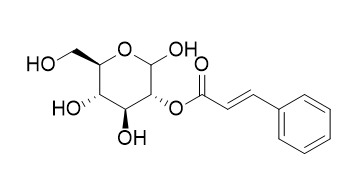2-O-cinnamoyl-beta-D-glucose
Reference standards.
Inquire / Order:
manager@chemfaces.com
Technical Inquiries:
service@chemfaces.com
Tel:
+86-27-84237783
Fax:
+86-27-84254680
Address:
1 Building, No. 83, CheCheng Rd., Wuhan Economic and Technological Development Zone, Wuhan, Hubei 430056, PRC
Providing storage is as stated on the product vial and the vial is kept tightly sealed, the product can be stored for up to
24 months(2-8C).
Wherever possible, you should prepare and use solutions on the same day. However, if you need to make up stock solutions in advance, we recommend that you store the solution as aliquots in tightly sealed vials at -20C. Generally, these will be useable for up to two weeks. Before use, and prior to opening the vial we recommend that you allow your product to equilibrate to room temperature for at least 1 hour.
Need more advice on solubility, usage and handling? Please email to: service@chemfaces.com
The packaging of the product may have turned upside down during transportation, resulting in the natural compounds adhering to the neck or cap of the vial. take the vial out of its packaging and gently shake to let the compounds fall to the bottom of the vial. for liquid products, centrifuge at 200-500 RPM to gather the liquid at the bottom of the vial. try to avoid loss or contamination during handling.
Anal Bioanal Chem.2018, 410(5):1561-1569
Postharvest Biol Tec2019, 149:18-26
Food Funct.2024, 15(4):1852-1866.
Plant J.2021, 107(6):1711-1723.
Cancers (Basel).2021, 13(9):2223.
FASEB J.2019, 33(2):2026-2036
J Cell Biochem.2018, 119(2):2231-2239
Curr Eye Res.2018, 43(1):27-34
Chin J Appl. Physiol.2019, 35(3):283-288
J Food Biochem.2019, 43(9):e12970
Related and Featured Products
Planta Med. 2000 Dec;66(8):753-6.
Galloyl esters from rhubarb are potent inhibitors of squalene epoxidase, a key enzyme in cholesterol biosynthesis.[Pubmed:
11199136 ]
METHODS AND RESULTS:
Galloyl glucoses and galloyl proanthocyanidins obtained from rhubarb (Rhei Rhizoma, Rheum palmatum L., Polygonaceae); e.g. 1,2,6-tri-O-galloyl-beta-D-glucose (IC50 = 0.63 microM), 1,6-di-O-galloyl-2-O-cinnamoyl-beta-D-glucose (IC50 = 0.58 microM), procyanidin B-2 3,3'-di-O-gallate (IC50 = 0.54 microM), and procyanidin B-5 3,3'-di-O-gallate (IC50 = 0.55 microM), were found to be potent inhibitors of rat squalene epoxidase (SE). The inhibition at submicromolar level was far more potent than that of chemically synthesized substrate analogs.
CONCLUSIONS:
It was demonstrated for the first time that the cholesterol-lowering effect of rhubarb may be attributed to the potent inhibition activities of SE, a rate-limiting enzyme of cholesterol biogenesis.



